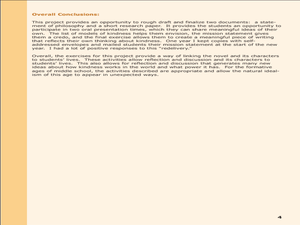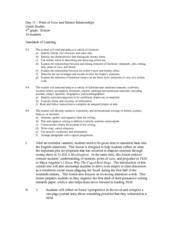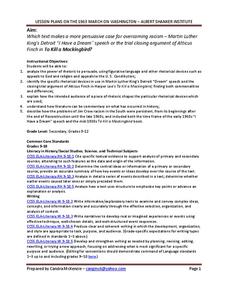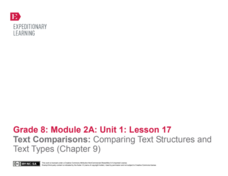Curated OER
To Kill A Mockingbird: Characterization
Students analyze several of the characters from "To Kill a Mockingbird". They view segments of the film, create character webs based on the most revealing film scenes, write journal entries and participate in class discussion.
Curated OER
Segmenting: To Kill a Mockingbird
Students divide the movie, To Kill a Mockingbird, on video disc into meaningful scenes, or segments using a digitizer. They name the segments and then choose examples that illustrate an instance of money, power, or human relationships....
Curated OER
To Kill a Mockingbird Details: Fun Trivia Quiz
Give this quiz to your class if you'd like to test their knowledge of ten details in To Kill a Mockingbird. This quiz is based on basic comprehension and recall of the text. While this is not the most academically challenging quiz, it...
Curated OER
Heroes, Kindness and "To Kill A Mockingbird"
Students read To Kill a Mockingbird and relate the action sof the characters to behaviors in students lives. In this heroism, bullying, kindness and compassion lesson, students identify characters who are heroes in the story. Students...
Curated OER
Language Arts, Social Studies, African Americans, The Blues, To Kill A Mockingbird
African American history during the Jim Crow era includes encounters with poverty, racism, disrespect, and protest. Harper Lee develops all four of these themes in her famous 1960 novel, To Kill a Mockingbird. To help students understand...
Curated OER
To Kill a Mockingbird
Students explore the components of racismas they read through Horton Foote's, "To Kill a Mockingbird." The trial of the main character reveals instances of justice in the face of prejudice and forms the focus of the lesson.
EngageNY
End of Unit 2 Assessment, Part 1: Drafting The Argument Essay
Scholars write the draft of their essays about Atticus's decision to defend Tom Robinson in Harper Lee's novel To Kill a Mockingbird. They support their claims with reasons, details, and quotes from the novel.
EngageNY
Launching the Readers Theater Groups: Allocating Key Quotes and Scenes
There's no I in collaboration! Scholars work in small groups to write a Readers Theater script for a scene from Harper Lee's To Kill a Mockingbird. Next, within their small groups, pupils discuss how their scenes communicate the main...
Curated OER
Point of View and Mentor Relationships
Tenth graders analyze the role of mentors, point of view, and prejudice using the texts of To Kill a Mockingbird and Maya Angelou's I Know Why the Caged Bird Sings. In this literature analysis lesson, 10th graders review Scout's...
Curated OER
Native Son
In this Native Son worksheet, students read a one page passage from the book and then explain how the extract related to To Kill a Mockingbird. Students answer in essay form.
Curated OER
Memory Box
In this To Kill a Mockingbird worksheet, students create a memory box for the character of Scout, Jem, Dill or Boo. Students follow the directions to complete the activity.
Curated OER
Literature: Mapping the Mockingbird
Young scholars read Harper Lee's To Kill a Mockingbird, focusing on setting. They list items that create mental images of the novel's setting along with location references to characters and events. Using posterboard, they construct...
Albert Shanker Institute
Making the Case for Equality: A Comparison
Martin Luther King Jr's " I Have a Dream" speech and Atticus Finch's closing argument during the trial of Tom Robinson both address the societal need to overcome racism. After examining the rhetorical devices and figurative language used...
EngageNY
Writing the First Draft of the Readers Theater Script
Scholars analyze a model Readers Theater script. Then, small groups read their scripts aloud to help determine where they need to make revisions.
West Jefferson High School
The Novel — Honor
For classes tackling To Kill a Mockingbird, this lesson plan sets readers up for discussions or essay writing with questions and prompts. The prompts encourage individuals to explore beyond the novel itself, looking at photographs from...
EngageNY
Text Comparisons: Comparing Text Structures and Text Types (Chapter 9)
Scholars revisit the comparisons they made in the previous lesson of "Incident" and To Kill A Mockingbird. They talk with their discussion appointment partners about the structure of a narrative and use a Compare and Contrast Note...
Curated OER
Mockingbird
In this science learning exercise, students explore animal facts as they read an informative paragraph about the mockingbird. Students then color the picture.
My Access
“Banning Books” Lesson Plan
To Kill a Mockingbird, Hunger Games, Brave New World. Welcome to Banned Books Week. As part of a study of censorship and book banning, class members investigate censorship, the purposes of censorship, and First Amendment rights,...
PBS
The History of Book Banning in America
Harry Potter, Are You There God? It's Me, Margaret, To Kill a Mockingbird. Kids view a slide show and then discuss the seven banned books featured in the presentation and the reasons why the books may have been banned.
EngageNY
Analyzing Character: Understanding Atticus (Chapter 1, cont.)
Scholars use a Note-catcher to gather text evidence to reveal the character of Atticus Finch in To Kill a Mockingbird. After collecting evidence, they work with a partner to make an inference about the character and then share their...
EngageNY
Close Reading: Focusing on Taking a Stand (Chapter 2 cont.)
Scholars complete a close read of To Kill a Mockingbird and determine why characters take a stand. They use text-dependent questions and Note-catchers to help guide their thinking. Readers review the Taking a Stand Anchor chart and...
EngageNY
Analyzing How Literature Draws on Themes from the Bible and World Religions: The Golden rule (Chapter 3)
Scholars use their Golden Rule Note-catcher to examine passages from To Kill a Mockingbird. They then take a gallery walk to compare and contrast the quotes before sharing Think-Write-Pair-Share ideas on how the quotes demonstrate the...
EngageNY
Inferring About Character: Atticus (Chapter 5)
As part of their study of Harper Lee's To Kill a Mockingbird, class members participate in a silent discussion of the novel using a Chalk Talk chart. They then respond to the teacher's questions by writing their thoughts on the chart....
EngageNY
Text to Film Comparison: Taking a Stand at the Jailhouse (Chapters 14-15)
Readers look closely at Scout in chapter 15 of To Kill A Mockingbird. Learners use turn and talk and Analyzing Scout's and the Reader's Perspectives Note-catcher to compare their perspectives to Scout's. They then make a comparison to...
Other popular searches
- To Kill a Mockingbird Unit
- To Kill a Mockingbird Test
- Kill a Mockingbird
- To Kill a Mockingbird Movie
- To Kill a Mockingbird Quizzes
- Reading to Kill a Mockingbird
- Injustice Mockingbird
- To Kill a Mockingbird Essay
- Kill Mockingbird
- To Kill a Mockingbirds
- Kill a Mockingbird Symbol
- To Kill Mockingbird

























